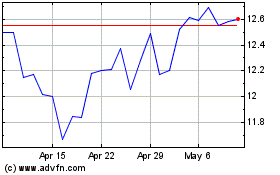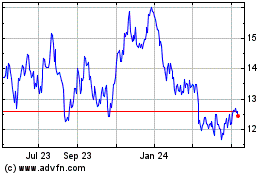Two More Dams at Risk, Brazil Mine Operator Samarco Warns
November 18 2015 - 5:46PM
Dow Jones News
By Reed Johnson And Luciana Magalhaes
SÃO PAULO--As a massive stream of sludge unleashed by the mining
industry's worst-ever dam break flowed through southeastern Brazil
to the Atlantic Ocean this week, the mine's operator said two more
of its dams could be at risk of collapsing.
Samarco Mineração SA, a joint mining venture owned by
Anglo-Australian BHP Billiton Ltd. and Vale SA of Brazil, said
Wednesday that it is taking emergency measures to stabilize
pressure levels at the two at-risk dams, named Germano and
Santarém, in the mountains of Minas Gerais state.
The structures, known as tailings dams, are earthen embankments
built to contain water and mineral waste from the mines. Company
officials said that both dams are operating with "safety factors"
lower than those recommended for maintaining equilibrium between
the dam's structure and pressure from the wastes that could cause
it to rupture.
"We reiterate once again that Samarco has been engaging all its
efforts to minimize the effects of the accident and take preventive
measures in order to increase the safety factors of the two
structures," the company wrote in an email.
The acknowledgment of the new measures to secure those dams
comes almost two weeks after another Samarco tailings dam, the
Fundão, used to store iron-ore waste, burst open, unleashing
billions of gallons of mud. The company previously had said two
dams broke on Nov. 5, but it has in recent days clarified that it
was only one.
Officials still are trying to add up the economic and
environmental costs of the deluge that sent an immense wave of
water and mining waste crashing into villages and farms many miles
downstream in the southeast states of Minas Gerais and Espirito
Santo.
At least 11 people were killed in the disaster and 12 more are
unaccounted for. Authorities have said that hundreds of thousands
of people were left without drinking water.
Earlier this week, public prosecutors said Samarco has agreed to
set aside about $260 million to fund initial cleanup efforts
following the catastrophe. The gesture hasn't quelled criticism of
the mining companies or predictions by some environmentalists,
academics and financial analysts that the total bill could climb
into the billions of dollars.
A Samarco spokeswoman declined to comment.
Officials of the country's chief federal environmental agency,
Ibama, said the contaminated water is expected to reach the
Atlantic Ocean as early as Friday, after coursing through the Doce
River, one of Brazil's longest.
Long stretches of the Doce turned a murky orange several days
ago, and fishermen and local government officials have reported
dire impacts on the fish population as well as a potential threat
to turtles spawning downstream. Scientists rescued some fish and
placed them in tanks in hopes of someday restocking the river.
Many environmentalists believe it will take years, if not
decades, before the disaster's full impact can be measured.
Fernanda Pirillo, an Ibama environmental emergencies
coordinator, said Samarco is taking preventive measures to minimize
the impact, such as placing containment barriers between the river
and the sea. But these steps can't completely contain the damage,
which extends along 300 miles of river, she said.
Samarco has dispatched tanker trucks to distribute water to
communities in the Doce basin that are facing shortages and
rationing.
Mining company officials have yet to provide any explanation of
how the dam break occurred. Vale and Billiton officials repeatedly
have said the disaster is Samarco's responsibility, but some
Brazilian authorities and lawyers say that claim won't be enough to
shield the parent companies from legal action.
Ms. Pirillo said that, under federal environmental law, the fine
levied for any single environmental infraction must be limited to
50 million reais, or about $13 million. She said this maximum limit
hasn't been updated for the last 17 years.
"The view of Ibama is that there should be no limit," she
said.
Write to Reed Johnson at Reed.Johnson@wsj.com and Luciana
Magalhaes at Luciana.Magalhaes@dowjones.com
Subscribe to WSJ: http://online.wsj.com?mod=djnwires
(END) Dow Jones Newswires
November 18, 2015 17:31 ET (22:31 GMT)
Copyright (c) 2015 Dow Jones & Company, Inc.
Vale (NYSE:VALE)
Historical Stock Chart
From Mar 2024 to Apr 2024

Vale (NYSE:VALE)
Historical Stock Chart
From Apr 2023 to Apr 2024
